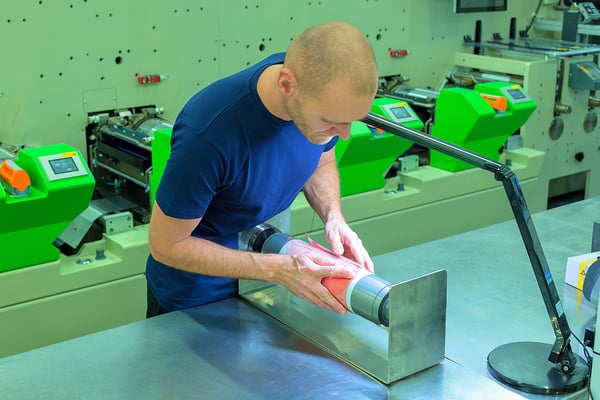Share this
10 Common Causes of Print Misregistration in Flexographic Printing
by Luminite on Oct 12, 2023 10:45:00 AM

We've all had that moment when we're painting, tracing, or gluing something and in our intense concentration, our hand slips, marring our precious work.
That's what print misregistration is like. To get the best possible print, the alignment of your ink combinations on the substrate must be precise. Misregistration by the tiniest fraction of an inch can completely skew your print.
It impacts everything from color patterns to design accuracy. It also means downtime for troubleshooting. For your printing process, that means:
- Wasted time
- Wasted substrate and ink
- Unnecessary wear and tear on machinery
- Delays in delivering prints
Assessing your flexo print registration for these common causes can help your operation save money and undue hassle.
10 Common Causes of Print Misregistration
If you're experiencing any amount of flexo misregistration, one of the following circumstances is probably occurring:
- Inaccurate plate mounting / centering
- Impression cylinder concentricity
- Cylinder/ plate/ sleeve condition
- Gear condition
- Idle rollers drag or rotate irregularly
- Malfunctioning web guide
- Web growth or fanning out
- Wandering web
- Substrate surface tension
- Incorrect tolerances
Here's how to troubleshoot and fix these issues:
1. Inaccurate Plate Mounting/Centering
Whether using cameras, mirrors, or the naked eye, the exact centerline of the printing cylinder, plate, or sleeve should be identified. The cylinder or sleeve must be mounted in the same location and orientation.
2. Impression Cylinder Concentricity
Your cylinder’s concentricity (a tolerance zone for the median points of a cylindrical or spherical part) must be close to perfect as possible. A dial indicator capable of showing errors down to 0.0001 inches should be mounted on a magnetic base and used to produce measurements from the middle and near each end of the cylinder.
Generally accepted flexo printing guidelines say total concentricity run out shouldn’t be more than about 0.0005 inches.
3. Cylinder/Plate/Sleeve Condition
Physical defects and ink/grease buildup can easily skew your reproduced images. Clean your plate, cylinder, and sleeve to remove any grime. Inspect your printing surface for damage like cuts and indentations.
4. Gear Condition
Missing gear teeth and general gear misalignment can create flexo print misregistration issues. Make sure all gears are intact and positioned properly. The plate cylinder gear must fit the cylinder journal with a tolerance no greater than 0.002 inches of error.
Also make sure the gears are clear of excess grease and foreign materials.
5. Idle Rollers Drag or Rotate Irregularly
Dragging or wobbly rotation makes accurate ink transfer impossible. Your inked image carrier will not be making contact with the substrate at the proper time and place.
6. Malfunctioning Web Guide
The web guide is a closed-loop system, which includes:
- Sensor
- Controller
- Actuating cylinder
- Web
The sensor gives error signals to the controller to adjust velocity differential across the web. Correct sensor prepositioning is critical.
7. Web Growth or Fanning Out
The web width gradually grows as it travels from one station to the next, causing print misregistration as images are applied in layers. You can use prepress software or bustle wheels to compensate for the growth.
8. Wandering Web
Any lateral movement of your web will cause print issues. Manipulate the tension at the splicer to hold your substrate steady.
9. Substrate Surface Tension
If surface tension is off, it will not correctly absorb and distribute pressure to transfer ink from the image carrier. Keep tension at an appropriate level so the image carrier contacts the substrate evenly and uniformly.
10. Incorrect Tolerances
Register shifts can cause two letters, words, or designs printed next to each other to overlap or misalign. Make sure images with different colors are more than twice the image trap dimension from each other.
Troubleshooting Flexo Print Misregistration and Other Defects
Much can go wrong on a printing press, but making sure mechanical components and pre-press calibrations are correct will avoid costly print misregistration errors.
If you’re having issues troubleshooting your press, check out our free guide to diagnosing printing defects!
Editor's Note: This blog post was originally published on November 2017 and was updated October 2023.
Share this
- Flexographic Printing (81)
- Image Carrier (28)
- Elastomer sleeves (27)
- Ink Transfer (25)
- Quality (22)
- Flexo sleeve (20)
- News (18)
- printing defects (18)
- flexo printing defects (17)
- sustainability (13)
- Flexo Troubleshooting (12)
- Ink (12)
- Digital Printing (10)
- Flexo 101 (10)
- Flexo Inks, (9)
- Anilox (7)
- Blister Packaging (7)
- Cost (6)
- print misregistration (6)
- regulations (6)
- Corrugated Printing (4)
- pinholing (4)
- "Tradeshow (3)
- Digital Flexo (3)
- Gravure Printing (3)
- Insider (3)
- Load-N-Lok (3)
- Wide Web (3)
- direct laser engraving (3)
- flexo-equipment-accessories (3)
- gear marks (3)
- halo (3)
- testing (3)
- Narrow Web (2)
- bridging (2)
- feathering (2)
- filling in (2)
- mottled image (2)
- pressure (2)
- Labelexpo (1)
- dirty prints (1)
- doughnuts (1)
- embossing (1)
- kiss impression (1)
- October 2023 (2)
- September 2023 (1)
- August 2023 (1)
- July 2023 (3)
- June 2023 (1)
- May 2023 (5)
- April 2023 (1)
- March 2023 (2)
- February 2023 (1)
- January 2023 (3)
- December 2022 (1)
- October 2022 (3)
- September 2022 (2)
- August 2022 (2)
- July 2022 (3)
- May 2022 (1)
- April 2022 (4)
- March 2022 (2)
- February 2022 (5)
- January 2022 (7)
- December 2021 (1)
- November 2021 (3)
- October 2021 (2)
- September 2021 (1)
- August 2021 (1)
- July 2021 (3)
- June 2021 (1)
- May 2021 (4)
- April 2021 (4)
- March 2021 (4)
- February 2021 (2)
- December 2020 (1)
- November 2020 (1)
- October 2020 (2)
- September 2020 (1)
- August 2020 (3)
- July 2020 (2)
- June 2020 (3)
- May 2020 (1)
- April 2020 (1)
- November 2019 (3)
- October 2019 (1)
- August 2019 (1)
- July 2019 (1)
- April 2019 (1)
- March 2019 (1)
- January 2019 (1)
- October 2018 (2)
- August 2018 (1)
- July 2018 (1)
- June 2018 (1)
- February 2018 (2)
- October 2017 (1)
- September 2017 (2)
- January 2016 (1)
- February 2015 (1)
- January 2015 (1)
- December 2014 (2)
- September 2014 (1)
- February 2014 (1)
- January 2014 (1)
- December 2013 (3)
- October 2013 (1)
- September 2013 (1)
- June 2013 (1)
- January 2013 (1)



Comments (7)